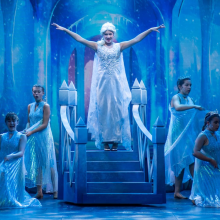Casting
Character Breakdown
Always first on the scene for any major film opening, and she has the Hollywood scoop. This is a perfect non-singing role for a student with a great speaking voice who isn’t quite ready for a lead.
Hollywood’s leading man in silent film. Charming and charismatic, Don has no shortage of female admirers. Don is smart and levelheaded; he likes being a famous Hollywood actor, but he doesn’t let the celebrity hype go to his head. Cast your best male singer and actor in this role, and someone who pairs well with Kathy.
A glamorous star of Hollywood’s silent films. She believes everything amazing she reads about herself in the gossip magazines, including that she and Don Lockwood are madly in love. Your actress will have to work to accomplish the right amount of exasperating ditz to bring this character to life. Cast a confident, comedic actress who is not afraid to take positive risks and can keep Lina’s nasal, grating voice consistent throughout the entire show.
Often serves as the comic relief in the show. Quick-witted and sure-footed, Cosmo is fast with a one-liner to lighten the mood. Cosmo is Don’s right-hand man, and it’s great to cast someone who physically contrasts with Don. Cast someone with great comedic chops and a strong musical sense as he leads many numbers in the show.
Always by Lina’s side, or trailing after her. As Lina’s manager, Roz works hard to make sure nothing upsets her. This non-singing character is a great supporting role for a promising young actress.
The studio’s director for Lamont and Lockwood films. He’s loud and blustery, and he’s easily frustrated with his assistants and Lina. This is a perfect non-singing role for an actor with a big voice who can show his frustration as he works to complete his first talkie.
Dexter’s 1st, 2nd and 3rd Assistants are great featured roles for ensemble members who are new to the stage.
Wants to become an actress. She takes her career as an artist seriously and is embarrassed that she has to take jobs like singing and popping out of a cake just to get by. Cast your strongest singer and actress who can easily portray an honest likability as well as a tough exterior. An actress who pairs well with Don is also important as they have many scenes together.
The vocal coaches hired to turn Lina’s voice into cultured perfection and to work with all of the other actors in the show. Tough, proper and slightly overworked, these characters are great roles to feature your hard-working ensemble members. These are non-solo singing roles.
Lina’s right-hand gal, who informs her that Kathy’s voice is being dubbed over hers. Zelda can be dramatic and over-the-top like Lina, but at her core, she cares about her friend. This is a fantastic featured role for a confident performer who is unafraid to make bold choices.
A natural leader. This role can be male or female and should be one of your stronger singers. This actor doesn’t need to be an excellent dancer, but he or she needs to command the stage with an air of confidence.
Broadway Dancers #1 and #2 are featured in "Broadway Melody" and should be excellent singers and dancers.
The Chorus Girls #1, #2, #3 and #4 are great featured singing roles in “Make ’Em Laugh.” They don’t need to be great singers as long as they can convey character and are able to be heard.
Stagehands #1, #2 and #3 are great featured singing roles in “Make ’Em Laugh.” They don’t need to be great singers as long as they can convey character and are able to be heard.
The ensemble roles in Singin’ In The Rain JR. are comprised of the Crowd, Pedestrians, including Pedestrian #1 and Pedestrian #2, Stars, Fans, including Fan #1 and Fan #2, Policeman, Party Guests, including Young Lady, Kathy's Girls, Chorus Girls, Broadway Chorus, Guests, a Sound Engineer, Stagehands, Students, Sound Crew, Screening Guests, a Passerby, the Butler, Orchestra Leader and Audience Members.
They really make the 1920s Golden Age of Hollywood come alive and are essential to this romantic light-hearted comedy. These ensemble groups are filled with named characters who have lines, so many of your ensemble students will have featured moments. Depending on your cast size, these ensemble groups can all be double or triple cast. Even if you have actors playing three or four different ensemble roles, emphasize the importance of character, and make sure your young performers make consistent character choices when they step onstage.




